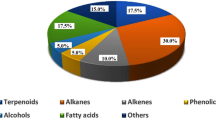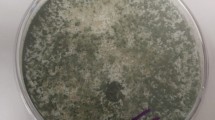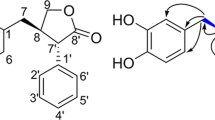Abstract
MANY aromatic compounds containing halogen substituents activated by the presence of electronegative groups, particularly nitro groups, in ortho and para positions are fungitoxic. For example, 2,4-dinitrofluoro-benzene and its 5-halogenated derivatives protect cotton fabric from attack by Myrothecium verrucaria1, 1,5-dichloro-2,4-dinitrobenzene is a soil fungicide2 and l-chloro-2,4-dinitronaphthalene controls a number of plant pathogenic fungi3. The influence of the introduction of a carboxy or carboalkoxy substituent into compounds of this type has not received much attention although the fungicidal activity of certain chlorodinitrobenzoates is reported in recent patent literature4.
This is a preview of subscription content, access via your institution
Access options
Subscribe to this journal
Receive 51 print issues and online access
$199.00 per year
only $3.90 per issue
Buy this article
- Purchase on SpringerLink
- Instant access to full article PDF
Prices may be subject to local taxes which are calculated during checkout
Similar content being viewed by others
References
Rosenberg, H., and Mosteller, J. C., Indust. Eng. Chem., 45, 2283 (1953).
Forsberg, J. L., Illinois State Florists' Assoc. Bull., 153, 1 (1954); Chem. Abstr., 43, 3618.
Soenen, A., and Werotte, L., Agricultura (Louvain), 4, 241 (1956).
U.S. Patent, 2,841,522 (Wolf, C. N., to Pittsburgh Coke and Chemical Co.) (1958).
Borsche, W., and Bahr, H., Liebigs Ann., 402, 81 (1914).
Stubbs, J., Proc. Third Intern. Cong. Crop Prot., 2, 79 (Paris, 1952).
Zimmerman, P. W., and Hitchcock, A. E., Contr. Boyce Thompson Inst., 12, 321 (1942).
Minarik, E. E., Ready, D., Norman, A. G., Thompson, H. E., and Owings, J. F., Bot. Gaz., 113, 135 (1951).
Horsfall, J. G., Principles of Fungicidal Action, 195 (Chronica Botanica Co., Waltham, U.S.A., 1956).
Owens, R. G., and Novotny, H. M., Contr. Boyce Thompson Inst., 19, 463 (1958).
Owens, R. G., and Blaak, G., Contr. Boyce Thompson Inst., 20, 475 (1960).
Burchfield, H. P., and Storrs, E. E., Contr. Boyce Thompson Inst., 19, 417 (1958).
Blanksma, J. J., and Schreinemachers, H. H., Rec. Trav. chim. Pays-Bas, 52, 428 (1933).
Bost, R. W., Turner, J. O., and Norton, R. D., J. Amer. Chem. Soc. 54, 1985 (1932).
Author information
Authors and Affiliations
Rights and permissions
About this article
Cite this article
SUMMERS, L., TURNER, J. Fungitoxicity of 2,4-Dichloro-3,5-dinitrobenzoates. Nature 197, 495–496 (1963). https://doi.org/10.1038/197495a0
Issue date:
DOI: https://doi.org/10.1038/197495a0



